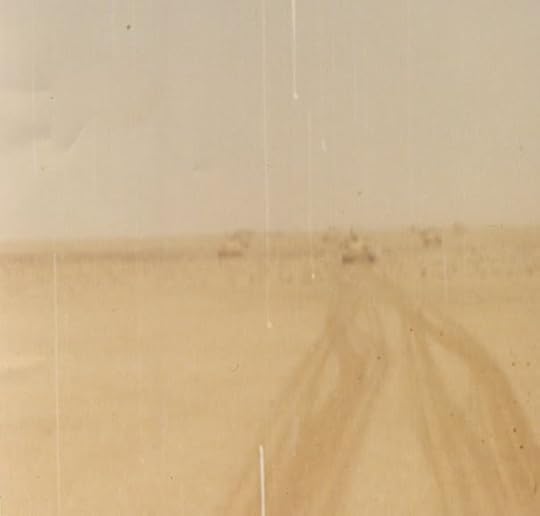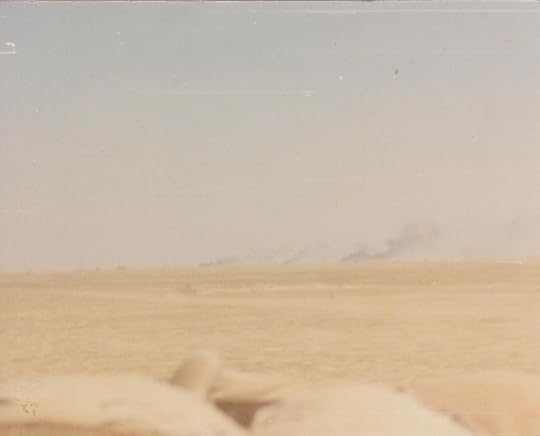A Borderline Crossed, and the delivery of a powerful and urgent message
(Author's note: Many of my recollections about Operation Desert Sabre (originally Desert Sword) are somewhat hazy; much of that because during all of the first 72 hours of the Operation, I didn't get even one second of sleep, and wound up getting all of 5 minutes for the first four days. As a result, the whole thing is somewhat blurry and fused all together.)
After the initial fear and Zen-like focus of crossing into Iraq, the rest of the day of the 24th (24 FEB 1991) generally progressed in a distinctly un-terrifying way: we ran into essentially no resistance, and met all of our objectives without incident. Despite our initial good fortune we were traveling at a good clip, which meant we had to refuel fairly frequently. Refueling in the field is dicey enough, but add the stress of being in an active combat zone (even if we weren't actively being shot at right that moment), and it became downright frightening. Of all the things I did as a tanker, the first refueling operation inside Iraq during the ground war was one of the scariest. Imagine this: you're standing on the back deck of a tank, with a fire extinguisher and an open fueling port, watching to see that the fuel tanks don't become overfilled. First, you're standing on top of the tank. As opposed to, say, being safely ensconced inside the 70 ton (combat loaded, less kits) beast made of rolled homogeneous steel, a secret blend of other armors, and depleted uranium, as any sane person would be. Second, you're in a situation already known to be dangerous enough that US Army protocols dictate a soldier stand right there with one of the tank's portable fire extinguishers in his hands while you're performing it. Third, at any moment, an enemy unit, helicopter (*shudder* perish the thought), or aircraft might get lucky, and catch you with your pants around your ankles refueling, which makes you a fantastic target for being shot. And, as if that weren't enough, fourth (and finally) my eyes, and the eyes of my tank's gunner, SGT Planter, were on the fuel level, not the horizon, meaning our particular tank would be caught wholly unprepared if an enemy were to appear. We were not alone, there was air cover, the 4th Squadron (Long Knife) of the 3d ACR had Kiowa and Apache helicopters nearby, and the rest of our own Squadron and Troop were setting security while refueling operations were in progress. That knowledge does not alleviate the anxiety, just for the record. We would wind up refueling a few more times over the ground war, none of which were quite as tense as the first one.
 Looking back toward the Combat Trains of C Troop, 1/3 ACR
Looking back toward the Combat Trains of C Troop, 1/3 ACR
As we continued on, day drifted into night as a blanket of dark dropped over the featureless and empty desert. Navigating in this terrain is next to impossible during the day, but at night it becomes truly impossible … unless you have GPS, which was brand-new then. So brand new, in fact, that we had exactly 2 GPS receivers in the Troop, one with the CO in C-66—the Troop command tank—and one with the XO with the combat trains†. They would communicate occasionally over the Troop's logistical radio freq, to ensure they stayed on course (and to avoid communicating over the combat/command net, which was kept mostly radio "quiet" for combat communications). As the tank's loader, it is my responsibility to keep air guard, when I'm not actively loading the main gun or performing other duties inside the turret, so I kept my focus—and machine gun—pointed toward the rear-left of the tank. I didn't see much of the desert in front of us, but I got good looks at the things we passed. With the onset of evening, I retrieved the night vision goggles, and kept them around my neck for easy retrieval if necessary. The Troop stopped just long enough for the vehicle's drivers to insert their own night-vision equipment, and then we resumed our march. That first night brought the first problem: during our march, we came across some elevated road surfaces that bypassed an unseen feature of the terrain (and, to this day, I still have no idea what it was). The driver of our scout platoon leader's Bradley CFV misjudged the edge of the roadway, and his Bradley rolled over the edge of the embankment injuring the platoon leader and one of the other scouts in the vehicle. We stopped long enough to recover the vehicle, medevac the wounded, and then continued on.
 Destroyed enemy vehicles as we pass them, northbound
Destroyed enemy vehicles as we pass them, northbound
Dawn the second day (25 FEB) came, and we started to run into pockets of enemy resistance. Occasional firefights would break out, and since C Troop was (along with B Troop) the front edge of the Regiment's right flank, we caught a lot of these as we swept north toward the Euphrates valley. Mostly, what would happen is that one or other scout platoon would observe enemy defensive positions, the tank platoons would come up and exchange a volley or two of fire with them, and they'd surrender. Sometimes, the enemy troops would surrender when the Bradleys came into view. We began routing hundreds and hundreds of POWs back through the MPs, and continued our advance. The closer we got to the Tigris and Euphrates rivers, the more frequently we would encounter enemy resistance. This continued unabated for all of the second day, night, and third day (26 FEB).
Starting on the night of the 26th, things became much more … interesting, let's say … and after two days and nights of unbroken advance across a trackless, formless desert, we paused: for an attack on a small town, occupied by a built-up tank and mechanized force of 2nd-tier Iraqi troops (that is, not the Republican Guard—we were still quite a ways from them—but the topmost tier of the regular Iraqi army). We got a radioed FRAGO, halted in place, and set security while Regiment initiated an artillery and rocket barrage on the town's defenders. After about an hour and a half of arty, we executed a hasty attack on the edge of the town. Several firefights broke out, and a few Iraqi tanks were destroyed, but after a few minutes these soldiers surrendered just like all the others had.
During all of our operations, we continued to have basic, normal human needs: eating, drinking, using the latrine. We had a vast stock of MREs on each tank, so food was never an issue. We also had a vast stock of water, believe it or not; each tank went into combat with (IIRC) four cases of 1L bottles of water, plus each of us had two full 2L desert-issue canteens inside the tank, and drank from them frequently (the bottled water, mostly, went into refilling the 2L canteens when they became empty). Many of us—this loader, in particular—also had a crippling addiction to caffeine, and since we weren't stopping hardly at all, it became more and more difficult to make coffee when blood levels became too low for sustained wakefulness. I had caffeine pills (Vivarin® was a favorite), but I preferred to save them for the utmost end of need. Instead, I took to essentially eating the instant coffee packets from the MREs. Only two of us on my tank, SGT Planter and myself, really drank coffee anyway, so it was easy to score the packets from both SPC Thomas and the LT. I'd take two of them and a sugar packet, rip them all open together, and dump their contents into my mouth. One swig of water later, and it was done. It's not the tastiest way to ingest caffeine, but the mother of invention being what she was …
(to be continued …)
†: CO = Commanding Officer, XO = Executive Officer (the 2nd in command of a given unit). Combat Trains refers to the ancillary vehicles of the unit, such as supply, medical, maintenance, etc. These vehicles generally run a few hundred meters behind the "line" vehicles (the tanks and scout Bradleys, in our case), to keep them out of immediate danger, but close enough to provide support to the combat vehicles, if needed. FRAGO = FRAGment Order (that is, not a complete order); a FRAGO is used to signal a unit they have been assigned some task that is different from what their existing orders tell them to do. In this case, we had existing orders to drive north to the river valley with all due speed, and to destroy or render ineffective any enemy units we encountered along the way. Since there was a built-up enemy position discovered, we needed more time and deliberate effort to attack their position, so our orders were temporarily overridden by a FRAGO for the hasty attack.
After the initial fear and Zen-like focus of crossing into Iraq, the rest of the day of the 24th (24 FEB 1991) generally progressed in a distinctly un-terrifying way: we ran into essentially no resistance, and met all of our objectives without incident. Despite our initial good fortune we were traveling at a good clip, which meant we had to refuel fairly frequently. Refueling in the field is dicey enough, but add the stress of being in an active combat zone (even if we weren't actively being shot at right that moment), and it became downright frightening. Of all the things I did as a tanker, the first refueling operation inside Iraq during the ground war was one of the scariest. Imagine this: you're standing on the back deck of a tank, with a fire extinguisher and an open fueling port, watching to see that the fuel tanks don't become overfilled. First, you're standing on top of the tank. As opposed to, say, being safely ensconced inside the 70 ton (combat loaded, less kits) beast made of rolled homogeneous steel, a secret blend of other armors, and depleted uranium, as any sane person would be. Second, you're in a situation already known to be dangerous enough that US Army protocols dictate a soldier stand right there with one of the tank's portable fire extinguishers in his hands while you're performing it. Third, at any moment, an enemy unit, helicopter (*shudder* perish the thought), or aircraft might get lucky, and catch you with your pants around your ankles refueling, which makes you a fantastic target for being shot. And, as if that weren't enough, fourth (and finally) my eyes, and the eyes of my tank's gunner, SGT Planter, were on the fuel level, not the horizon, meaning our particular tank would be caught wholly unprepared if an enemy were to appear. We were not alone, there was air cover, the 4th Squadron (Long Knife) of the 3d ACR had Kiowa and Apache helicopters nearby, and the rest of our own Squadron and Troop were setting security while refueling operations were in progress. That knowledge does not alleviate the anxiety, just for the record. We would wind up refueling a few more times over the ground war, none of which were quite as tense as the first one.
 Looking back toward the Combat Trains of C Troop, 1/3 ACR
Looking back toward the Combat Trains of C Troop, 1/3 ACRAs we continued on, day drifted into night as a blanket of dark dropped over the featureless and empty desert. Navigating in this terrain is next to impossible during the day, but at night it becomes truly impossible … unless you have GPS, which was brand-new then. So brand new, in fact, that we had exactly 2 GPS receivers in the Troop, one with the CO in C-66—the Troop command tank—and one with the XO with the combat trains†. They would communicate occasionally over the Troop's logistical radio freq, to ensure they stayed on course (and to avoid communicating over the combat/command net, which was kept mostly radio "quiet" for combat communications). As the tank's loader, it is my responsibility to keep air guard, when I'm not actively loading the main gun or performing other duties inside the turret, so I kept my focus—and machine gun—pointed toward the rear-left of the tank. I didn't see much of the desert in front of us, but I got good looks at the things we passed. With the onset of evening, I retrieved the night vision goggles, and kept them around my neck for easy retrieval if necessary. The Troop stopped just long enough for the vehicle's drivers to insert their own night-vision equipment, and then we resumed our march. That first night brought the first problem: during our march, we came across some elevated road surfaces that bypassed an unseen feature of the terrain (and, to this day, I still have no idea what it was). The driver of our scout platoon leader's Bradley CFV misjudged the edge of the roadway, and his Bradley rolled over the edge of the embankment injuring the platoon leader and one of the other scouts in the vehicle. We stopped long enough to recover the vehicle, medevac the wounded, and then continued on.
 Destroyed enemy vehicles as we pass them, northbound
Destroyed enemy vehicles as we pass them, northboundDawn the second day (25 FEB) came, and we started to run into pockets of enemy resistance. Occasional firefights would break out, and since C Troop was (along with B Troop) the front edge of the Regiment's right flank, we caught a lot of these as we swept north toward the Euphrates valley. Mostly, what would happen is that one or other scout platoon would observe enemy defensive positions, the tank platoons would come up and exchange a volley or two of fire with them, and they'd surrender. Sometimes, the enemy troops would surrender when the Bradleys came into view. We began routing hundreds and hundreds of POWs back through the MPs, and continued our advance. The closer we got to the Tigris and Euphrates rivers, the more frequently we would encounter enemy resistance. This continued unabated for all of the second day, night, and third day (26 FEB).
Starting on the night of the 26th, things became much more … interesting, let's say … and after two days and nights of unbroken advance across a trackless, formless desert, we paused: for an attack on a small town, occupied by a built-up tank and mechanized force of 2nd-tier Iraqi troops (that is, not the Republican Guard—we were still quite a ways from them—but the topmost tier of the regular Iraqi army). We got a radioed FRAGO, halted in place, and set security while Regiment initiated an artillery and rocket barrage on the town's defenders. After about an hour and a half of arty, we executed a hasty attack on the edge of the town. Several firefights broke out, and a few Iraqi tanks were destroyed, but after a few minutes these soldiers surrendered just like all the others had.
During all of our operations, we continued to have basic, normal human needs: eating, drinking, using the latrine. We had a vast stock of MREs on each tank, so food was never an issue. We also had a vast stock of water, believe it or not; each tank went into combat with (IIRC) four cases of 1L bottles of water, plus each of us had two full 2L desert-issue canteens inside the tank, and drank from them frequently (the bottled water, mostly, went into refilling the 2L canteens when they became empty). Many of us—this loader, in particular—also had a crippling addiction to caffeine, and since we weren't stopping hardly at all, it became more and more difficult to make coffee when blood levels became too low for sustained wakefulness. I had caffeine pills (Vivarin® was a favorite), but I preferred to save them for the utmost end of need. Instead, I took to essentially eating the instant coffee packets from the MREs. Only two of us on my tank, SGT Planter and myself, really drank coffee anyway, so it was easy to score the packets from both SPC Thomas and the LT. I'd take two of them and a sugar packet, rip them all open together, and dump their contents into my mouth. One swig of water later, and it was done. It's not the tastiest way to ingest caffeine, but the mother of invention being what she was …
(to be continued …)
†: CO = Commanding Officer, XO = Executive Officer (the 2nd in command of a given unit). Combat Trains refers to the ancillary vehicles of the unit, such as supply, medical, maintenance, etc. These vehicles generally run a few hundred meters behind the "line" vehicles (the tanks and scout Bradleys, in our case), to keep them out of immediate danger, but close enough to provide support to the combat vehicles, if needed. FRAGO = FRAGment Order (that is, not a complete order); a FRAGO is used to signal a unit they have been assigned some task that is different from what their existing orders tell them to do. In this case, we had existing orders to drive north to the river valley with all due speed, and to destroy or render ineffective any enemy units we encountered along the way. Since there was a built-up enemy position discovered, we needed more time and deliberate effort to attack their position, so our orders were temporarily overridden by a FRAGO for the hasty attack.
Published on February 23, 2015 20:06
No comments have been added yet.



